KitchenAid KSDG950ESS1 Owner’s Manual
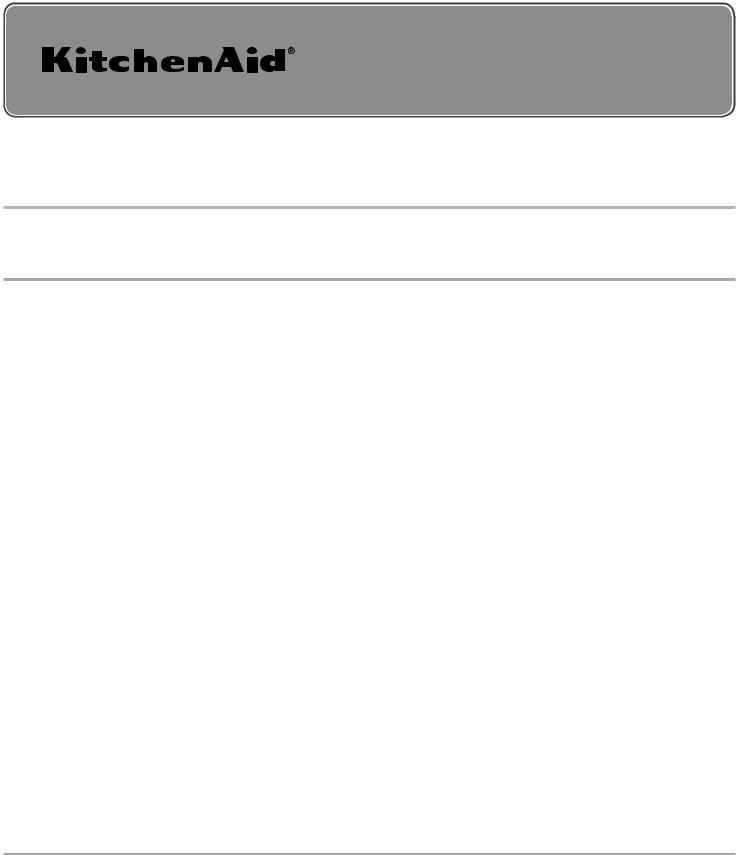
User Guide
Dual Fuel Downdraft Range
THANK YOU for purchasing this high-quality product. Register your range at www.kitchenaid.com. In Canada, register your range at www.kitchenaid.ca.
For future reference, please make a note of your product model and serial numbers. These can be found on the label located on the oven frame behind the top-right side of the oven door.
Model Number______________________________________________ |
Serial Number_______________________________________________ |
Para una versión de estas instrucciones en español, visite www.kitchenaid.com.
Deberá tener a mano el número de modelo y de serie, que están ubicados en el marco del horno, detrás del lado derecho superior de la puerta del horno.
Table of Contents |
|
RANGE SAFETY.............................................................................. |
2 |
The Anti-Tip Bracket..................................................................... |
3 |
KEY USAGE TIPS............................................................................ |
5 |
AquaLift® Self-Cleaning Technology............................................ |
5 |
Surface Temperatures................................................................... |
5 |
Preheating..................................................................................... |
5 |
Surface Burners............................................................................ |
5 |
FEATURE GUIDE............................................................................. |
6 |
Electronic Oven Controls.............................................................. |
9 |
COOKTOP..................................................................................... |
10 |
Surface Burners.......................................................................... |
11 |
Surface Grates............................................................................ |
12 |
Burner Size................................................................................. |
12 |
Griddle......................................................................................... |
12 |
Downdraft Ventilation System.................................................... |
12 |
Cookware.................................................................................... |
13 |
Home Canning............................................................................ |
13 |
OVEN.............................................................................................. |
14 |
Aluminum Foil............................................................................. |
14 |
Positioning Racks and Bakeware............................................... |
14 |
Roll-Out Rack............................................................................. |
15 |
Oven Vent.................................................................................... |
16 |
Sabbath Mode............................................................................ |
16 |
Baking and Roasting.................................................................. |
16 |
Broiling........................................................................................ |
17 |
Convection Cooking................................................................... |
17 |
Proofing Bread............................................................................ |
17 |
Cook Time................................................................................... |
18 |
Meat Probe................................................................................. |
18 |
Oven Light................................................................................... |
18 |
RANGE CARE................................................................................ |
19 |
Clean Cycle................................................................................. |
19 |
General Cleaning........................................................................ |
20 |
TROUBLESHOOTING................................................................... |
22 |
ACCESSORIES.............................................................................. |
24 |
WARRANTY................................................................................... |
25 |
W10896671A
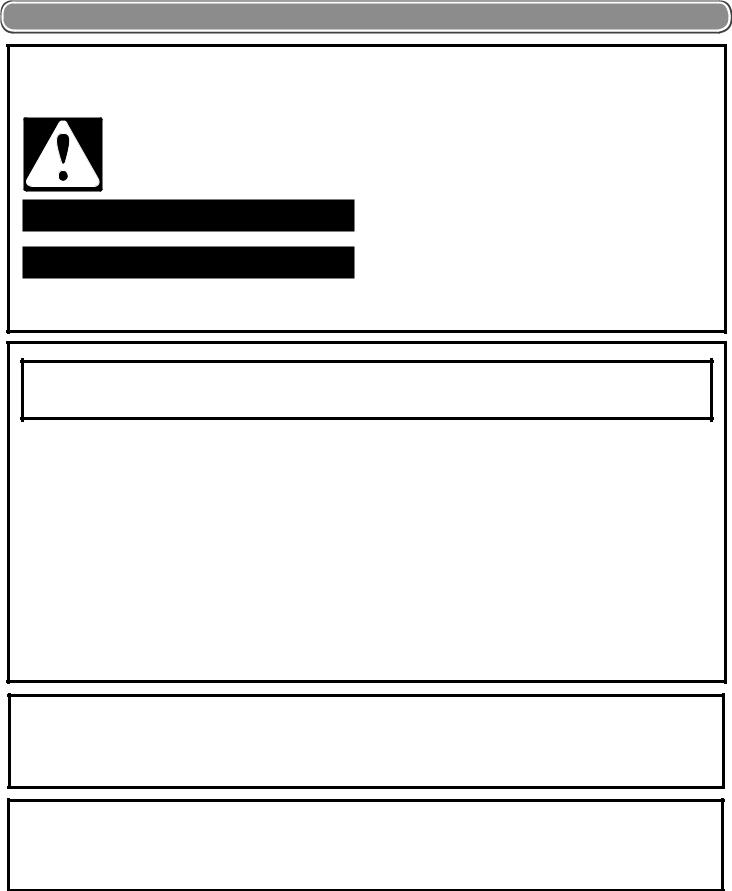
RANGE SAFETY
Your safety and the safety of others are very important.
many important safety messages in this manual and on your appliance. Always read and obey all safety
safety alert symbol.
alerts you to potential hazards that can kill or hurt you and others.
messages will follow the safety alert symbol and either the word “DANGER” or “WARNING.” mean:
 DANGER
DANGER  WARNING
WARNING
You can be killed or seriously injured if you don't immediately follow instructions.
You can be killed or seriously injured if you don't follow instructions.
All safety messages will tell you what the potential hazard is, tell you how to reduce the chance of injury, and tell you what can happen if the instructions are not followed.
WARNING: If the information in this manual is not followed exactly, a fire or explosion may result causing property damage, personal injury or death.
–Do not store or use gasoline or other flammable vapors and liquids in the vicinity of this or any other appliance.
–WHAT TO DO IF YOU SMELL GAS:
•Do not try to light any appliance.
•Do not touch any electrical switch.
•Do not use any phone in your building.
•Immediately call your gas supplier from a neighbor's phone. Follow the gas supplier's instructions.
•If you cannot reach your gas supplier, call the fire department.
–Installation and service must be performed by a qualified installer, service agency or the gas supplier.
WARNING: Gas leaks cannot always be detected by smell.
Gas suppliers recommend that you use a gas detector approved by UL or CSA.
For more information, contact your gas supplier.
If a gas leak is detected, follow the “What to do if you smell gas” instructions.
State of California Proposition 65 Warnings:
WARNING: This product contains one or more chemicals known to the State of California to cause cancer.
WARNING: This product contains one or more chemicals known to the State of California to cause birth defects or other reproductive harm.
2

The Anti-Tip Bracket
The range will not tip during normal use. However, the range can tip if you apply too much force or weight to the open door without having the anti-tip bracket fastened down properly.
 WARNING
WARNING
Tip Over Hazard
A child or adult can tip the range and be killed.
Verify the anti-tip bracket has been properly installed and engaged per installation instructions.
Re-engage anti-tip bracket if range is moved.
Do not operate range without anti-tip bracket installed and engaged.
Failure to follow these instructions can result in death or serious burns to children and adults.
Anti-Tip



 Bracket
Bracket
Range Foot
To verify the anti-tip bracket is installed and engaged:
•Slide range forward.
•Look for the anti-tip bracket securely attached to floor or wall.
•Slide range back so rear range foot is under anti-tip bracket.
•See installation instructions for details.
3

IMPORTANT SAFETY INSTRUCTIONS
WARNING: To reduce the risk of fire, electrical shock, injury to persons, or damage when using the range, follow basic precautions, including the following:
■ WARNING: TO REDUCE THE RISK OF TIPPING OF THE RANGE, THE RANGE MUST BE SECURED BY PROPERLY INSTALLED ANTI-TIP DEVICES. TO CHECK IF THE DEVICES ARE INSTALLED PROPERLY, SLIDE RANGE FORWARD, LOOK FOR ANTI-TIP BRACKET SECURELY ATTACHED TO FLOOR OR WALL, AND SLIDE RANGE BACK SO REAR RANGE FOOT IS UNDER ANTI-TIP BRACKET.
■ WARNING: NEVER use this appliance as a space heater to heat or warm the room. Doing so may result in carbon monoxide poisoning and overheating of the oven.
■ WARNING: NEVER cover any slots, holes or passages in the oven bottom or cover an entire rack with materials such as aluminum foil. Doing so blocks air flow through the oven and may cause carbon monoxide poisoning. Aluminum foil linings may also trap heat, causing a fire hazard.
■ CAUTION: Do not store items of interest to children in cabinets above a range or on the backguard of a range – children climbing on the range to reach items could be seriously injured.
■Do Not Leave Children Alone – Children should not be left alone or unattended in area where the range is in use. They should never be allowed to sit or stand on any part of the range.
■Wear Proper Apparel – Loose-fitting or hanging garments should never be worn while using the range.
■User Servicing – Do not repair or replace any part of the range unless specifically recommended in the manual. All other servicing should be referred to a qualified technician.
■Storage in or on the Range – Flammable materials should not be stored in an oven or near surface units.
■Do Not Use Water on Grease Fires – Smother fire or flame or use dry chemical or foam-type extinguisher.
■Use Only Dry Potholders – Moist or damp potholders on hot surfaces may result in burns from steam. Do not let potholder touch hot heating elements. Do not use a towel or other bulky cloth.
■DO NOT TOUCH SURFACE UNITS OR AREAS NEAR UNITS – Surface units may be hot even though they are dark in color. Areas near surface units may become hot enough to cause burns. During and after use, do not touch, or let clothing or other flammable materials contact surface units or areas near units until they have had sufficient time to cool. Among those areas are the cooktop and surfaces facing the cooktop.
■Never Leave Surface Units Unattended at High Heat Settings – Boilover causes smoking and greasy spillovers that may ignite.
■Glazed Cooking Utensils – Only certain types of glass, glass/ceramic, ceramic, earthenware, or other glazed utensils are suitable for range-top service without breaking due to the sudden change in temperature.
■Utensil Handles Should Be Turned Inward and Not Extend Over Adjacent Surface Units – To reduce the risk of burns, ignition of flammable materials, and spillage due to unintentional contact with the utensil, the handle of a utensil should be positioned so that it is turned inward, and does not extend over adjacent surface units.
■Clean Cooktop With Caution – If a wet sponge or cloth is used to wipe spills on a hot cooking area, be careful to avoid steam burn. Some cleaners can produce noxious fumes if applied to a hot surface.
■Use Care When Opening Door – Let hot air or steam escape before removing or replacing food.
■Do Not Heat Unopened Food Containers – Build-up of pressure may cause container to burst and result in injury.
■Keep Oven Vent Ducts Unobstructed.
■Placement of Oven Racks – Always place oven racks in desired location while oven is cool. If rack must be moved while oven is hot, do not let potholder contact hot heating element in oven.
■DO NOT TOUCH HEATING ELEMENTS OR INTERIOR SURFACES OF OVEN – Heating elements may be hot even though they are dark in color. Interior surfaces of an oven become hot enough to cause burns. During and after use, do not touch, or let clothing or other flammable materials contact heating elements or interior surfaces of oven until they have had sufficient time to cool. Other surfaces of the appliance may become hot enough to cause burns – among these surfaces are oven vent openings and surfaces near these openings, oven doors, and windows of oven doors.
■Proper Installation – The range, when installed, must be electrically grounded in accordance with local codes or, in the absence of local codes, with the National Electrical Code, ANSI/NFPA 70. In Canada, the range must be electrically grounded in accordance with Canadian Electrical Code. Be sure the range is properly installed and grounded by a qualified technician.
■Disconnect the electrical supply before servicing the appliance.
■Injuries may result from the misuse of appliance doors or drawers such as stepping, leaning, or sitting on the doors or drawers.
■Maintenance – Keep range area clear and free from combustible materials, gasoline, and other flammable vapors and liquids.
■Top burner flame size should be adjusted so it does not extend beyond the edge of the cooking utensil.
For self-cleaning ranges –
■Do Not Clean Door Gasket – The door gasket is essential for a good seal. Care should be taken not to rub, damage, or move the gasket.
■Do Not Use Oven Cleaners – No commercial oven cleaner or oven liner protective coating of any kind should be used in or around any part of the oven.
■Clean Only Parts Listed in Manual.
■Before Self-Cleaning the Oven – Remove broiler pan and other utensils. Wipe off all excessive spillage before initiating the cleaning cycle.
For units with ventilating hood –
■Clean Ventilating Hoods Frequently – Grease should not be allowed to accumulate on hood or filter.
■When flambéing foods under the hood, turn the fan on.
SAVE THESE INSTRUCTIONS
4
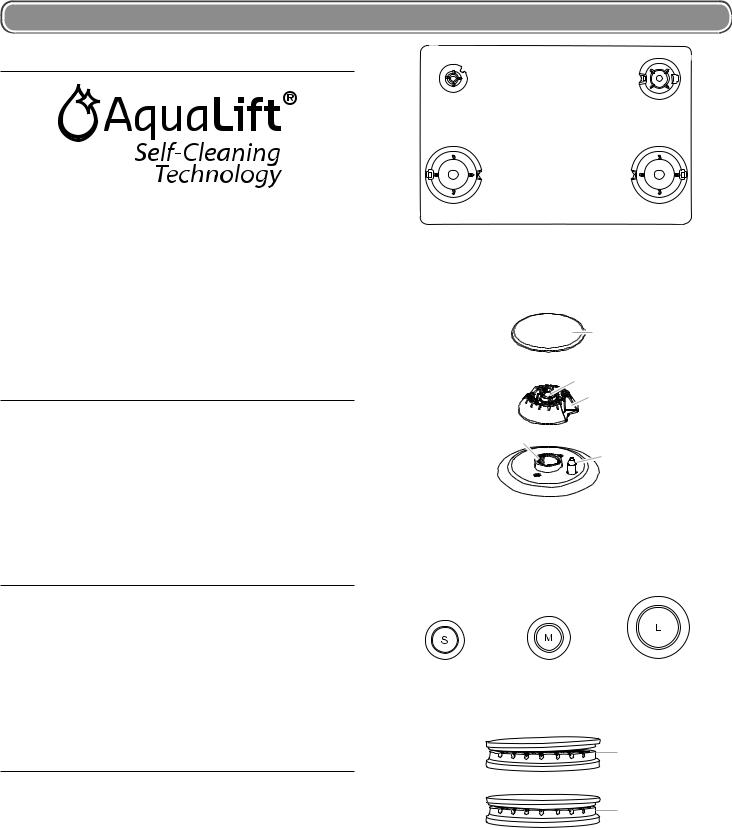
KEY USAGE TIPS
AquaLift® Self-Cleaning Technology
A C
AquaLift® Self-Cleaning Technology is a first-of-its-kind cleaning solution designed to minimize the time, temperature, and odors that ordinarily come with traditional self-cleaning methods. With AquaLift® Self-Cleaning Technology, an exclusive coating on the interior of the oven, is activated with heat and water to release baked-on soil. To use AquaLift® Self-Cleaning Technology, simply wipe out loose debris, pour water into the oven bottom, and run the AquaLift® Self-Cleaning cycle. When the cycle finishes in under 1 hour at a lower temperature than in traditional self-cleaning methods, just wipe out the remaining water and loose debris.
See the “Clean Cycle” section for more detailed instructions. For additional information, frequently asked questions, and videos on using AquaLift® Self-Cleaning Technology, visit our website at http://whirlpoolcorp.com/aqualift.
Surface Temperatures
When the range is in use, all range surfaces may become hot, such as the knobs and oven door.
Baking Drawer (On Some Models)
When the oven is in use, the drawer may become hot. Do not store plastics, cloth, or other items that could melt or burn in the drawer.
Oven Vent
The oven vent releases hot air and moisture from the oven and should not be blocked or covered. Do not set plastics, paper, or other items that could melt or burn near the oven vent.
Preheating
When beginning a Bake, Convect Bake, or Convect Roast cycle, the oven will begin preheating after Start is pressed. The oven will take approximately 12 to 15 minutes to reach 350°F (177°C) with all of the oven racks provided with your oven inside the oven cavity. Higher temperatures will take longer to preheat. The preheat cycle rapidly increases the oven temperature. The actual oven temperature will go above your set temperature to offset the heat lost when your oven door is opened to insert food. This ensures that when you place your food in the oven, the oven will begin at the proper temperature. Insert your food when the
preheat tone sounds. Do not open the door during preheat before the tone sounds.
Surface Burners
The burner bases and caps must be properly positioned before cooking. Your range comes with 3 sizes of burners and caps. Each round burner base is marked with a letter indicating the burner size. Align the burner bases as shown in the following illustration:
B |
D |
A. Small (S) |
C. Medium (M) |
B. Large (L) |
D. Large (L) |
Align the gas tube opening in the burner base with the orifice holder on the cooktop and the igniter electrode with the notch in the burner base.
|
A |
|
B |
|
C |
E |
|
|
D |
A. Burner cap |
D. Igniter electrode |
B. Gas tube opening |
E. Orifice holder |
C. Burner base |
|
Place the burner caps on the appropriate burner bases. Each round burner cap is marked with a letter indicating the burner size.
Small cap (S) |
Medium cap (M) |
Large cap (L) |
Burner caps should be level when properly positioned. If burner caps are not properly positioned, surface burners will not light. The burner cap should not rock or wobble when properly aligned.
A
B
A.Incorrect
B.Correct
5

FEATURE GUIDE
This manual covers several models. Your model may have some or all of the items listed. Refer to this manual or the Product Help section of our website at www.kitchenaid.com for more detailed instructions. In Canada, refer to the Product Help Section at www.kitchenaid.ca.
 WARNING
WARNING
Food Poisoning Hazard
Do not let food sit for more than one hour before or after cooking.
Doing so can result in food poisoning or sickness.
Keypad |
Feature |
Instructions |
|
|
|
|
|
CLOCK/TOOLS |
Clock |
The Clock can use a 12or 24-hour cycle. See the “Electronic Oven Controls” section. |
|
|
|
1. |
Press CLOCK/TOOLS until “CLOCK” is displayed. |
|
|
2. |
Use the number keypads to set the time of day. |
|
|
3. |
Press START to change the time. |
|
|
4. |
Press “3” for AM or “6” for PM. |
|
|
|
|
CLOCK/TOOLS |
Settings |
Enables you to personalize the audible tones and oven operation to suit your needs. |
|
|
|
See the “Electronic Oven Controls” section. |
|
OVEN LIGHT |
Oven cavity light |
The oven light is controlled by a keypad on the oven control panel. While the oven |
|
|
|
door is closed, press OVEN LIGHT to turn the light On and Off. When the oven door is |
|
|
|
opened, the oven light will automatically come On. |
|
TIMER SET/OFF |
Oven timer |
The Timer can be set in hours or minutes up to 9 hours and 59 minutes. |
|
|
|
1. |
Press TIMER SET/OFF. |
|
|
2. |
Press the number keypads to set the length of time in hr-min-min. Leading zeros |
|
|
|
do not have to be entered. For example, for 2 minutes, enter “2.” |
|
|
3. |
Press TIMER SET/OFF to begin the countdown. If enabled, end-of-cycle tones will |
|
|
|
sound at end of countdown. |
|
|
4. |
Press TIMER SET/OFF again to cancel the Timer and return to the time of day. |
|
|
|
Do not press the Cancel keypad because the oven will turn off. |
|
|
5. |
If the Timer is running but not in the display, press TIMER SET/OFF to display the |
|
|
|
countdown for 5 seconds. |
START |
Cooking start |
The Start keypad begins any oven function. If Start is not pressed within 2 minutes |
|
|
|
after pressing a keypad, the function is canceled and the time of day is displayed. |
|
CANCEL |
Range function |
The Cancel keypad stops any function for the appropriate oven or drawer, except |
|
|
|
the Clock and Timer. |
|
BAKE |
Baking and |
|
roasting |
1.Press BAKE.
2.Set the desired temperature between 170°F and 500°F (75°C and 260°C) using the number keypads. The default temperature is 350°F (180°C).
3.Press START.
4.To change the temperature, repeat steps 2 and 3.
5.Press CANCEL when finished.
6
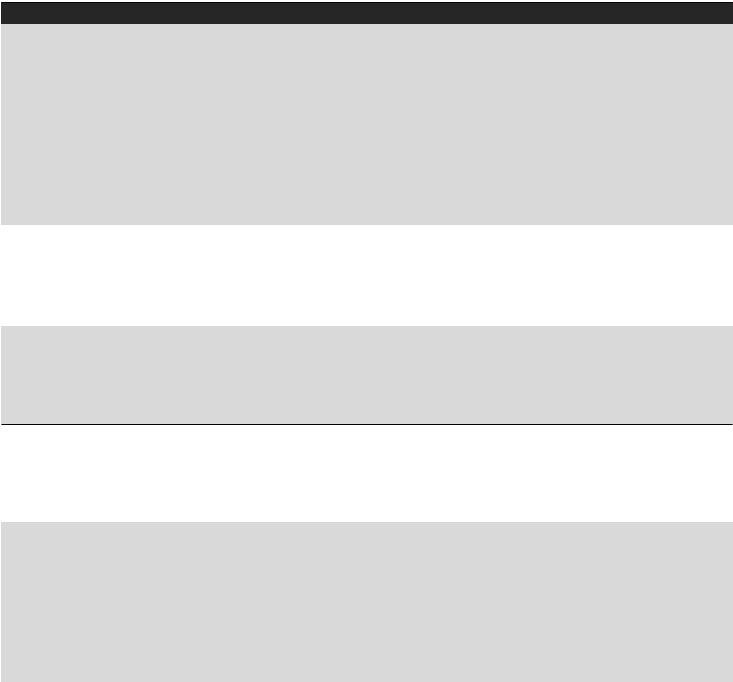
Keypad |
Feature |
Instructions |
|
|
|
|
|
STEAM BAKE |
Steam bake |
1. |
Insert the steam rack with water reservoir in the oven. |
|
|
2. |
Pour 11/2 cups (350 mL) of warm water into the water reservoir. |
|
|
|
NOTE: Do not fill past the MAX mark. |
|
|
3. |
Press STEAM BAKE. |
|
|
4. |
Press the number keypad to select the desired food option. |
|
|
5. |
Press the number keypads to set the temperature. |
|
|
6. |
Press START. |
|
|
7. |
(Optional) Press COOK TIME. Press the number keypads to set the cook time. |
|
|
8. |
Press START. |
|
|
9. |
Insert food when preheating finishes. |
|
|
10. |
Press CANCEL when finished. |
|
|
|
NOTE: Let oven cool before removing and emptying water reservoir. |
|
|
|
|
BROIL |
Broiling |
1. |
Press BROIL. |
|
|
2. |
Press the number keypads to set the desired temperature. |
|
|
3. |
Press START and allow the oven to preheat for 5 minutes. |
|
|
4. |
To change the temperature, repeat steps 2 and 3. |
|
|
5. |
Position the cookware in the oven, and then close the door. |
|
|
6. |
Press CANCEL when finished. |
|
|
|
|
PROOF |
Proofing bread |
1. |
Place prepared dough in oven. Press PROOF. |
|
|
2. |
Press START. |
|
|
|
Let the dough rise until nearly doubled in size. Proofing time may vary depending |
|
|
|
on dough type and quantity. |
|
|
3. |
Press CANCEL when finished proofing. |
Refer to the “Proofing Bread” section for more information.
KEEP WARM |
Hold warm |
Food must be at serving temperature before placing it in the warmed oven. |
|
|
|
1. |
Press KEEP WARM. |
|
|
2. |
Set the desired temperature between 145°F and 190°F (63°C and 88°C) using |
|
|
|
the number keypads. The default temperature is 170°F (75°C). |
|
|
3. |
Press START. |
|
|
4. |
Press CANCEL when finished. |
|
|
|
|
EASY CONVECT |
Convection |
1. |
Press EASY CONVECT BAKE. |
BAKE |
cooking |
2. |
Press “1” to have the oven automatically convert the temperature and time for |
|
|
|
convection baking. Press “2” to manually convert the temperature and time. |
|
|
3. |
Press the number keypads to set a temperature other than 325°F (177°C) in 5° |
|
|
|
increments between 170°F and 500°F (77°C and 260°C). |
|
|
4. |
Press START. |
|
|
5. |
(Optional) Press the number keypads to set a cook time. |
|
|
6. |
Press START. |
|
|
7. |
To change the temperature, repeat steps 2 and 3. |
|
|
8. |
Press CANCEL when finished. |
|
|
|
|
EASY CONVECT |
Convection |
1. |
Press EASY CONVECT BROIL. |
BROIL |
cooking |
2. |
Press “1” to have the oven automatically convert the temperature and time for |
|
|
|
convection baking. Press “2” to manually convert the temperature and time. |
|
|
3. |
Press the number keypads to set a temperature other than 325°F (177°C) in |
|
|
|
5° increments between 170°F and 500°F (77°C and 260°C). |
|
|
4. |
Press START. |
|
|
5. |
(Optional) Press the number keypads to set a cook time. |
|
|
6. |
Press START. |
|
|
7. |
To change the temperature, repeat steps 2 and 3. |
|
|
8. |
Press CANCEL when finished. |
|
|
|
|
7
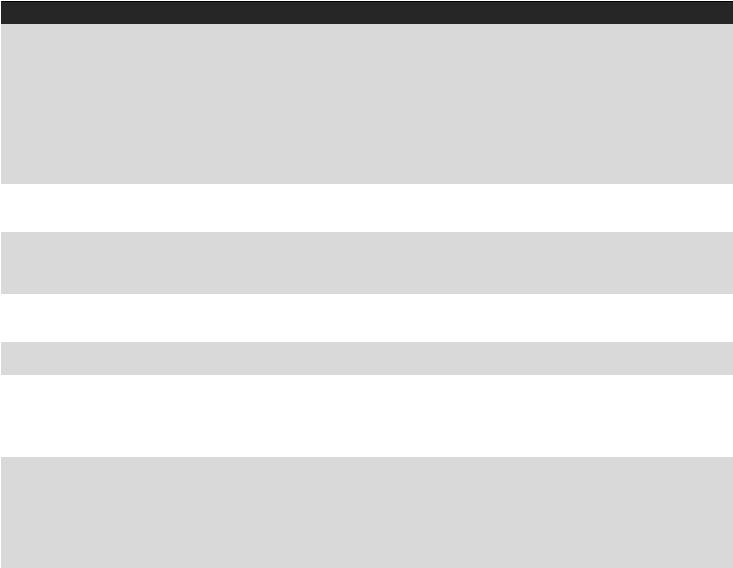
Keypad |
Feature |
Instructions |
|
|
|
|
|
EASY CONVECT |
Convection |
1. |
Press EASY CONVECT ROAST. |
ROAST |
cooking |
2. |
Press “1” to have the oven automatically convert the temperature and time for |
|
|
|
convection baking. Press “2” to manually convert the temperature and time. |
|
|
3. |
Press the number keypads to set a temperature other than 325°F (177°C) |
|
|
|
in 5° increments between 170°F and 500°F (77°C and 260°C). |
|
|
4. |
Press START. |
|
|
5. |
(Optional) Press the number keypads to set a cook time. |
|
|
6. |
Press START. |
|
|
7. |
To change the temperature, repeat steps 2 and 3. |
|
|
8. |
Press CANCEL when finished. |
|
|
|
|
COOK TIME |
Timed cooking |
Timed cooking allows the oven to be set to turn on at a certain time of day, cook for |
|
|
|
a set length of time, and/or shut off automatically. |
|
|
|
To set a Timed Cook or a Delayed Timed Cook, see the “Cook Time” section. |
|
|
|
|
|
DELAY START |
Delayed start |
The Delay Start keypad is used to enter the starting time for an oven function with |
|
|
|
a delayed start. Delay Start should not be used for foods such as breads and cakes |
|
|
|
because they may not bake properly. |
|
|
|
To set a Timed Cook or a Delayed Timed Cook, see the “Cook Time” section. |
|
|
|
|
|
DOWNDRAFT FAN |
Downdraft fan |
Press DOWNDRAFT FAN HIGH or DOWNDRAFT FAN LOW to turn on the Downdraft Fan |
|
HIGH/LOW/OFF |
|
at the desired speed. |
|
|
|
Press DOWNDRAFT FAN OFF to turn off the Downdraft Fan immediately. |
|
|
|
|
|
AQUALIFT SELF |
Clean cycle |
See the “Clean Cycle” section. |
|
CLEAN |
|
|
|
START |
Oven control |
1. |
Check that the oven is OFF. |
(Control Lock Hold |
lockout |
2. |
Press and hold START (Control Lock Hold 3 Sec) for 3 seconds. |
3 Sec) |
|
||
|
3. |
A tone will sound, and “Control Locked” will scroll, and then “Locked” will be displayed. |
|
|
|
||
|
|
4. |
Repeat to unlock. No keypads will function with the controls locked. The cooktop |
|
|
|
functions are not affected by the oven control lockout. |
|
|
|
|
CLOCK/TOOLS |
Energy save |
1. |
Press CLOCK/ TOOLS until “ENERGY SAVE” is displayed. |
|
|
2. |
The current setting will be displayed. |
|
|
3. |
Press the “1” keypad to adjust the setting. |
|
|
4. |
Press CANCEL to exit and display the time of day. |
|
|
|
If Energy Save is ON, the range will go into Sleep mode after 5 minutes of inactivity. |
|
|
|
Any keypad press will activate the display. If Energy Save is OFF, the display will be |
|
|
|
ON at all times. |
8
